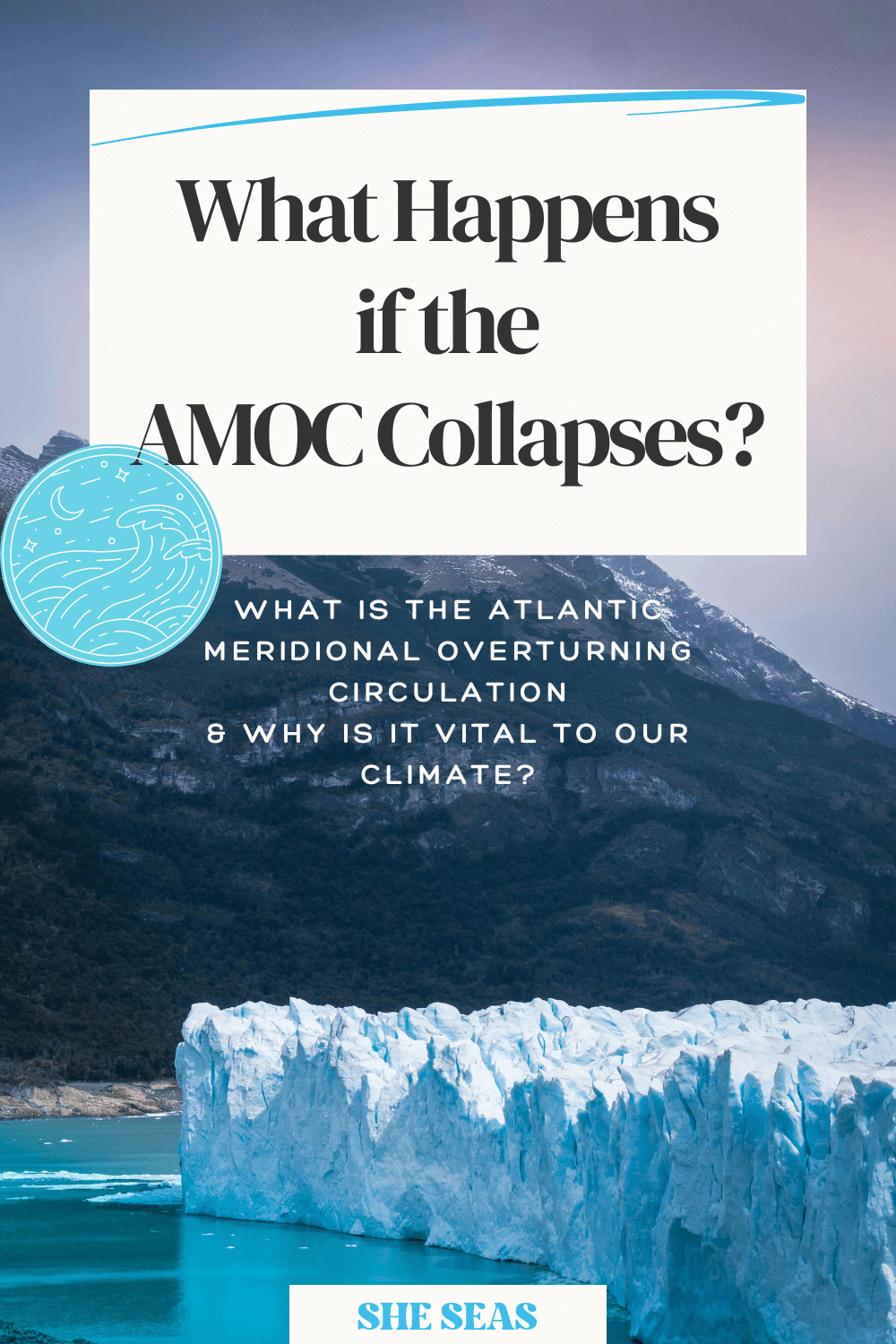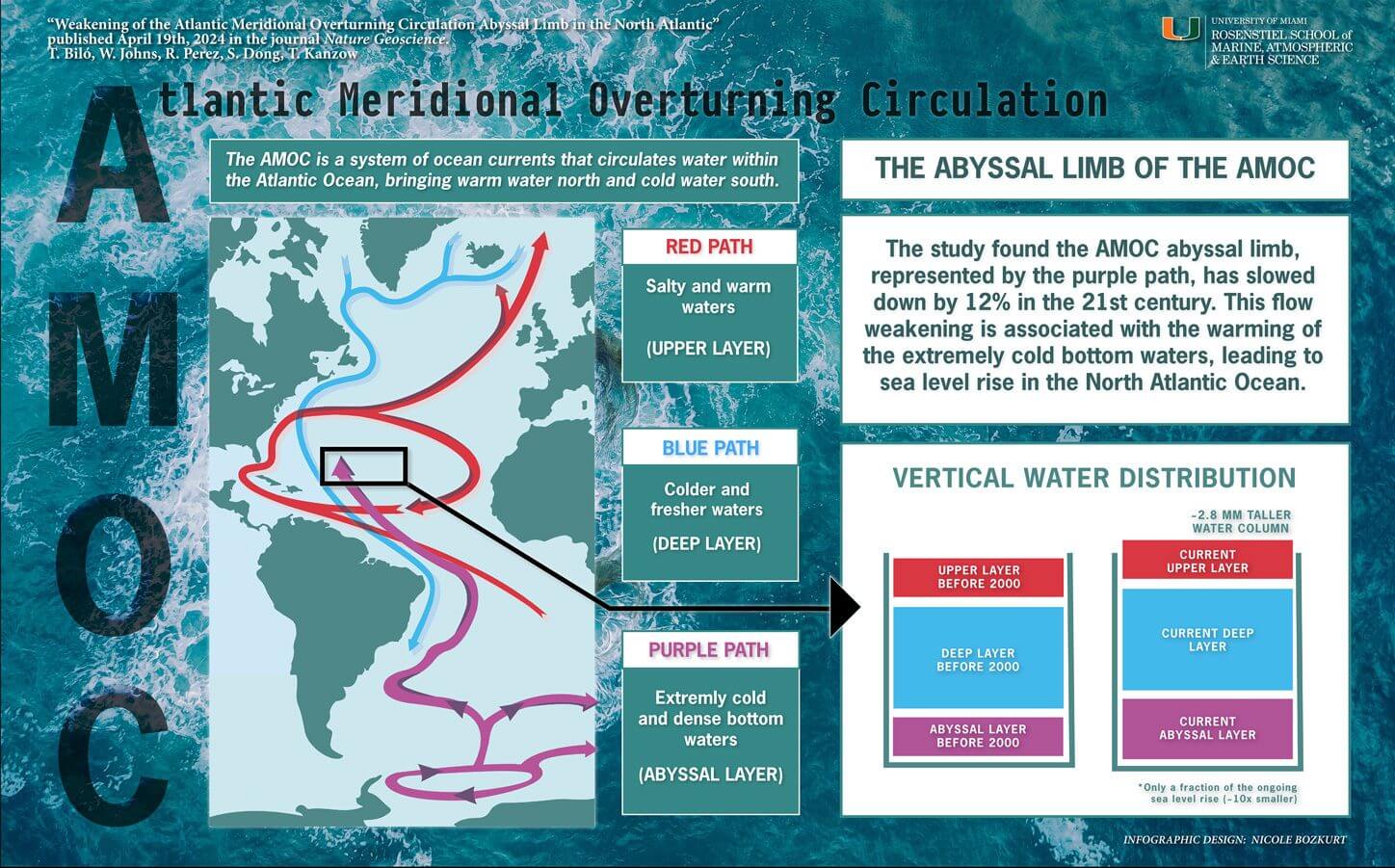What Happens if the AMOC Collapses?

Introduction
The Atlantic Meridional Overturning Circulation (AMOC) is one of the most critical components of our planet’s climate system, often referred to as the “global ocean conveyor belt.”
The AMOC plays a vital role in regulating the climate by transporting warm water from the tropics to the North Atlantic and returning cold water to the south.
However, recent studies and reports have raised alarming concerns about the potential collapse of the AMOC—a scenario that could have devastating consequences for global weather patterns, sea levels, and ecosystems. This incredibly unsettling hypotehtical was once thought of as higly unlikely, but some researchers believe it is now not only likely, it could happen sooner than previously believed.
Let’s dive into what the AMOC is, why it’s so important, and what could happen if this powerful ocean current system collapses.
What is the AMOC?
So what really is the AMOC and why is it important? The AMOC is a large system of ocean currents that circulates water within the Atlantic Ocean. Imagine it as a giant conveyor belt, moving warm, salty water from the equator northward toward the Arctic. When this warm water reaches the colder regions of the North Atlantic, it cools, becomes denser, and sinks deep into the ocean. This cold water then flows southward, completing the cycle.
This circulation process helps to distribute heat across the planet, playing a crucial role in maintaining the relatively mild climate in Europe. For example, the AMOC is a significant reason why Western Europe has much milder winters than regions at similar latitudes in North America. Beyond just temperature regulation, the AMOC influences global weather patterns, sea level changes, and the distribution of nutrients and oxygen in the ocean.

The AMOC is Weakening
In recent decades, scientists have observed worrying signs that the AMOC is weakening. This weakening has been observed through directly measuring the AMOC using a network of instruments across the Atlantic, particularly through projects like RAPID-MOCHA (Rapid Climate Change–Meridional Overturning Circulation and Heatflux Array). These instruments measure ocean temperature, salinity, and current speeds at various depths and locations, providing real-time data on the strength of the AMOC.
Studies have shown that the AMOC is at its weakest point in over a thousand years. The primary driver behind this weakening is believed to be climate change. As global temperatures rise due to increased greenhouse gas emissions, so do the temperatures of the ocean waters. This warming can disrupt the delicate balance of the AMOC.
Another significant factor contributing to the weakening of the AMOC is the melting of polar ice, particularly in Greenland. When ice melts, it releases a large amount of freshwater into the ocean. This influx of freshwater can dilute the salty waters of the North Atlantic, making them less dense and less likely to sink. This disruption in the sinking process is a critical part of what could lead to a slowdown—or even a collapse—of the AMOC.
What Happens if the AMOC Collapses?
The potential collapse of the AMOC was once depicted in the 2004 eco-apocalypse movie “The Day After Tomorrow”, and while the movie took some creative license, the reality could be equally dramatic and much more complex. If the AMOC were to collapse, the consequences could be far-reaching and severe, impacting everything from weather patterns to marine ecosystems and global food security.
1. Severe Weather Changes
One of the most immediate impacts of an AMOC collapse would be dramatic changes in weather patterns, particularly in the Northern Hemisphere. Europe could experience significantly colder winters, similar to the climate of present-day Canada. This cooling effect, sometimes referred to as “mini ice ages,” could lead to harsher winter conditions, longer cold spells, and potentially a complete transformation of the European climate.
On the other hand, the tropics and parts of Africa could become much hotter. The disruption of the AMOC would affect the distribution of heat globally, potentially leading to more extreme weather events, such as stronger hurricanes in the Atlantic and severe droughts in some regions.
2. Rising Sea Levels
The AMOC also plays a role in regulating sea levels. A collapse of this system could cause significant changes in sea levels, particularly along the eastern coast of the United States and in Western Europe. Without the stabilizing effect of the AMOC, sea levels in these regions could rise more quickly than the global average, leading to increased coastal erosion, more frequent flooding, and displacement of communities.
3. Impact on Marine Life
The AMOC is crucial for the health of marine ecosystems. It helps distribute nutrients and oxygen throughout the ocean, supporting the diverse range of marine life that relies on these resources. If the AMOC were to collapse, it could lead to a stagnation of waters in certain regions, causing a decline in marine biodiversity.
For example, the fisheries in the North Atlantic, which are some of the most productive in the world, could see dramatic declines in fish stocks. The collapse of these ecosystems would not only impact marine life but also the millions of people who depend on these fisheries for their livelihoods.
4. Global Food Security
The changes in climate and weather patterns resulting from an AMOC collapse could have profound effects on global food security. The colder temperatures in Europe could reduce agricultural yields, while increased droughts in other parts of the world could lead to crop failures. These disruptions could cause food shortages and drive up prices, exacerbating hunger and poverty in vulnerable regions.
The Ripple Effect: Beyond the Atlantic
While the AMOC is primarily an Atlantic phenomenon, its influence extends far beyond this ocean basin. The interconnected nature of the world’s climate systems means that changes in the AMOC could have ripple effects across the globe.
For instance, the disruption of the AMOC could alter the Indian and West African monsoons, which are critical for agriculture and water supplies in those regions. It could also impact the El Niño and La Niña cycles in the Pacific, leading to more extreme weather events worldwide.
How Soon Could the AMOC Collapse?
There is increasing concern that the Atlantic Meridional Overturning Circulation (AMOC) may collapse this century according to researchers at Utrect University.
The researchers use a state-of-the-art model to estimate when it could collapse, suggesting a shutdown could happen between 2037 and 2064 and suggests it’s more likely than not to collapse by 2050.
Other papers state the AMOC could collapse as early as 2025.
Much more research is being done and papers are being published, using different models and variables, but there seems to be no question that the weakening of the AMOC is a very serious concern to our planet.
In fact, the is evidence to suggest the AMOC has collapsed in the past. Studies of the Earth’s ancient climate suggest that the AMOC probably shut down around 13,000 years ago, during a natural warming period when large volumes of melting ice were pouring into the ocean. If it happened once, it can happen again.

Can We Prevent an AMOC Collapse?
Given the potentially catastrophic consequences of an AMOC collapse, the question on everyone’s mind is: Can we prevent it? The answer lies in addressing the root cause—climate change.
Reducing greenhouse gas emissions is crucial to slowing the pace of global warming and, in turn, preventing further weakening of the AMOC. International efforts like the Paris Agreement are steps in the right direction, but much more needs to be done. This includes transitioning to renewable energy sources, protecting and restoring forests, and promoting sustainable agricultural practices.
Additionally, more research is needed to better understand the AMOC and the factors that influence it. Monitoring the AMOC and other critical components of the Earth’s climate system is essential for early detection of any significant changes. By improving our understanding, we can develop more effective strategies to mitigate the risks.
The Role of Individuals in the Global Picture
While global policies and scientific research are vital and are of the utmost importance, everyday people also have a role to play. We need to see a global shift in individual lifestyles to reduce carbon footprints, by using energy-efficient appliances, reducing car travel and investing in electric transportation, supporting sustainable businesses, eliminating wasteful overconsumption, and reducing meat consumption, particularly beef. These steps can collectively make a significant impact.
Raising awareness about the importance of the AMOC and the risks of its collapse is also crucial. By educating others and advocating for stronger climate action, individuals can help build the momentum needed for broader societal change.
Conclusion
The potential collapse of the AMOC is a stark reminder of the delicate balance that sustains life on Earth. The warning signs are there, and the time to act is now. By addressing the underlying causes of climate change, investing in renewable energy, and supporting global efforts to reduce emissions, we can help protect the AMOC and, by extension, the planet’s climate system.
This isn’t just a scientific issue—it’s a human one. The future of our climate, our ecosystems, and our way of life depends on the decisions we make today. By taking action, we can work towards a future where the AMOC continues to flow, supporting a stable and thriving planet for generations to come.













